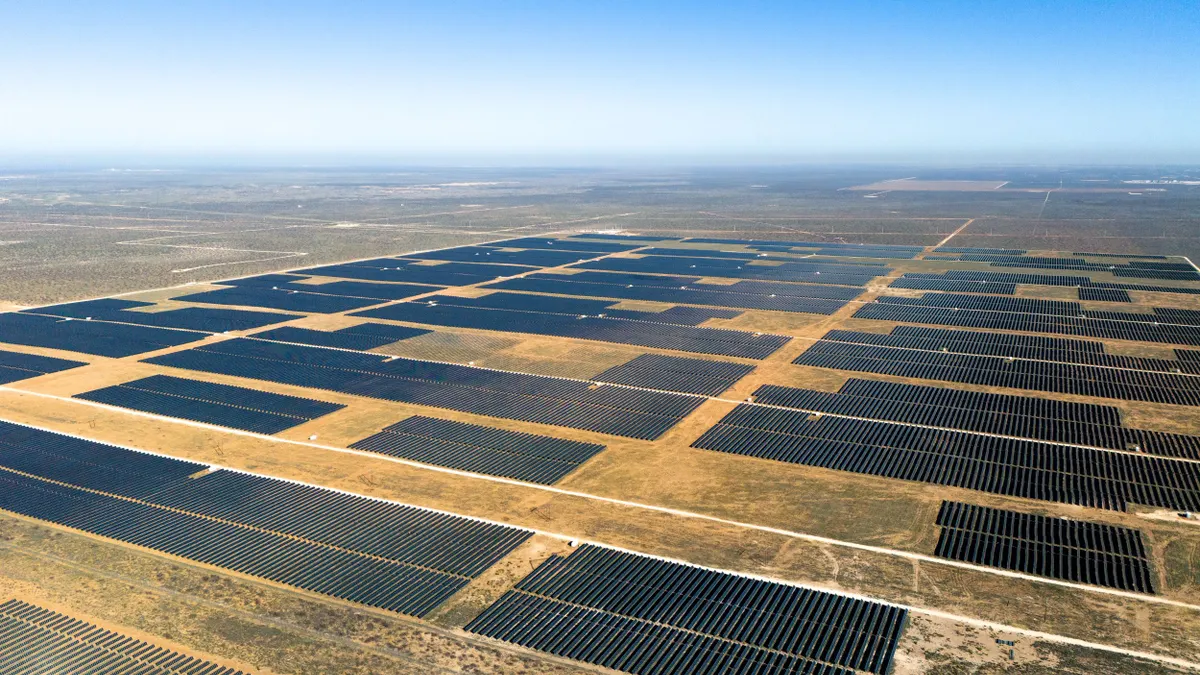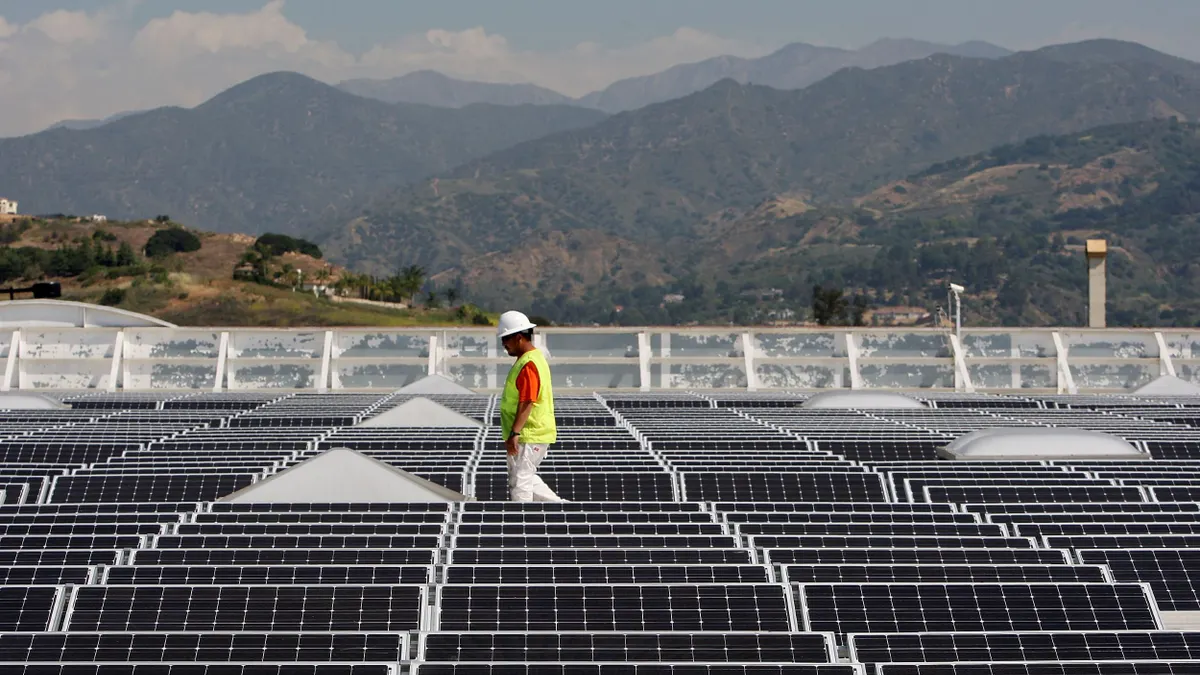Until last week, Arizona was the last place where you would expect a compromise over rooftop solar policy.
The state’s major utilities and solar companies have battled over compensation rates for rooftop solar (a policy known as retail net metering) for the past five years. And though those debates are common across the U.S., Arizona attracted national attention for bitter regulatory election cycles and accusations of dark money and corruption.
But now, after the conclusion of Arizona’s widely-watched value of solar docket that ended retail rate net metering at the end of last year, solar advocates and the biggest utility in the state struck a deal last week over rate design and rooftop solar compensation. The decision gave policy certainty to solar companies and alleviates some of the tension in regulatory proceedings.
Arizona Public Service Co. (APS) and 30 other intervenors in its pending rate case outlined a series of alternative rate designs that include voluntary residential demand charges and time-of-use rates for both solar and non-solar ratepayers.
Under the agreement, new rooftop solar customers would be paid $0.129/kWh for excess energy exported to the grid and about $0.105/kWh for solar power consumed by end users themselves, though exact rates would vary by customer usage patterns and rate design. The export rate would decline 10% annually for new rooftop solar systems, but customers would lock in their rates for 10 years when they sign up.
Parallel to that agreement, solar companies and APS agreed to stand by that settlement if approved and refrain from undermining it until 2019.
“In this particular one we had a diverse group of 40 intervening parties that were part of our rate case,” Greg Bernosky, director of regulatory affairs at APS told Utility Dive. “And we wondered ‘can we find a consensus agreement that works for the most number of parties and the discussions led us to [this] outcome.’” However out of the 40 parties, only 30 signed onto the deal.
The settlement echoes a trend of utilities and solar interests coming to the table and hashing out deals palatable to both sides in New York and Colorado. However Arizona’s differs from those notable deals in that regulators already decided to end the state’s net metering policy before both sides came to the table.
“The settlement is evidence that APS and others see the need to provide customers a chance to go solar,” said Alex McDonough, vice president of policy for one the largest solar installers, Sunrun. “We don’t think the settlement serves as a model to encourage innovation — it’s not ideal but workable. We’re able to stay in the market.”
Arizona’s solar saga
After years of contested net metering and rate design proceedings, the ACC consolidated solar compensation debates into a value of solar proceeding in 2015.
“It is anticipated that the Value of [distributed generation (DG)] docket will yield significant new information about how DG solar should be compensated,” wrote Administrative Law Judge Jane Rodda in a staff recommendation.
While the mechanics of DER valuation are complex, the outlines of the debate in Arizona and elsewhere are simple: Utilities argue rooftop solar customers do not pay their fair share to maintain the grid, pushing those costs onto non-solar customers.
Solar companies, meanwhile, say utilities fail to recognize the full benefits of solar — including environmental attributes and deferment of costly infrastructure upgrades.
While regulators collected data and information for the VOS docket, three utilities filed requests last year to cut the compensation rate or implement mandatory demand charges on solar customers, aiming to eliminate the perceived “cost shift.” APS was one of them.
Demand charges apply a fee for the highest amount of peak usage in a given time period — usually a month. Typically applied to commercial and industrial customers, a growing number of utilities have sought to levy them on residential consumers to better cover fixed costs of the grid.
Solar and consumer advocates condemned the mandatory residential demand charge proposals in Arizona, saying they were too complex to understand and would essentially negate any savings from net metering.
After months of hearings in the value of solar docket, regulators decided to suspend retail rate net metering, but did not immediately set new compensation rates. Those decisions would come, they said, as a part of individual utility rate cases — the same venue where the demand charges and other rate changes were being debated.
While exact compensation rates were not decided, regulators laid out broad parameters for rooftop solar payments in the VOS order. Solar customers would lock in their export rates for 10 years, which Commissioner Doug Little said would give them enough time to recoup their investment.
“Ten years is a period of time that most people should be able to recover their investment,” Little told Utility Dive. “And, in some cases, it will be shorter; it some cases it might be a little longer and the reason it varies is because every person’s financial picture is different.”
The eventual compensation rates would step down each year, regulators wrote, and rooftop solar customers would be placed in their own rate class — a decision industry advocates worried could hurt those customers in upcoming rate cases where new rates are decided.
“The biggest outcome of this decision is uncertainty, but we are concerned because its proposed methodologies seem to systematically undervalue distributed solar,” Briana Kobor, policy director for solar advocacy group Vote Solar, said shortly after the VOS decision was issued.
Striking the agreement with APS now gives solar interests some sort of policy certainty, at least until the next rate case.
The art of the compromise
Compromise, or rather the lack thereof, became the theme of the VOS proceeding after the decision was issued. Commissioner Little had unsuccessfully tried to negotiate a compromise over solar rates between SolarCity and APS mid-2016. Talks fell apart after a day as both sides failed to come to an agreement.
During the last day of the VOS proceeding right before the decision was issued, solar interests derided a perceived aversion to compromise from regulators and utilities.
“We are open to moving away from net metering [in Arizona]," Anne Hoskins, a former Maryland regulator now head of policy for solar installer Sunrun said during the hearing. But, she added, solar companies were not being given a chance throughout the proceeding.
Commissioner Little took issue with that characterization.
“I wanted the process to be fully litigated,” he told Utility Dive during the annual winter meeting hosted by the National Association of Regulatory Utility Commissioners. “I wanted to make sure every group had every opportunity to present evidence so that we would have a true record where everybody was afforded due process and everyone had the opportunity to have their complete say.”
“To come to an open meeting after a yearlong process and to say ‘we weren’t given the opportunity to give a compromise’ is disingenuous.” Little said. “They had a year.”
With retail net metering eliminated after the VOS docket, utilities and solar advocates turned their attention to the proposed demand charges.
In its initial rate case, APS proposed a three-tier rate (called the R3 rate) that would implement demand charges for solar customers while cutting the offset rate—the bill credit for solar customers for the energy they consume on site from their own arrays — to only 0.06/kWh. The utility proposed an export credit of $0.11/kWh. That rate would further undermine the value proposition of rooftop solar if approved, according to Austin Perea, a GTM Research solar analyst.
“The DG (distributed generation) economics certainly deteriorates within the next few years if the R3 rate went into effect,” Perea told Utility Dive.
With that context, solar companies and APS sat down and negotiated a deal that eliminated the mandatory demand charges and outlined four alternative rate design options for both solar and non-solar ratepayers. It ensured all ratepayers will see their rates rise only 4.6% or by $6 instead of the proposed $11. The settlement is also a first step into putting all APS customers on some form of time-of-use rate in a couple of years, Bernosky said.
Rooftop solar customers can choose from four rate design options that include a time-of-use rate plan with a grid access charge or a demand-based rate plan without a grid access charge.
Along with the rate design, parties also hammered out a compromise compensation scheme based on the VOS docket parameters.
The deal sets the export rate for rooftop solar energy for this year at $0.129/kWh, which will step down no more than 10% annually in years to come for new customers. Customers would receive the export rate of the year of their interconnection application for 10 years. Conversely, the offset rate, according to the settlement, will be determined by the "load profile and production profile of APS customers with DG."
For now, the settlement estimates the offset rate would be about $0.105/kWh, but will depend on "individual usage patterns and DG system size, orientation, and production." The offset rate would be lower for demand charge rate options, likely between $0.096 and $0.078/kWh.
The export and offset rates would be lower than current retail rate net metering compensation in Arizona, between $0.13/kWh and $0.14/kWh for residential customers. Existing solar customers would be grandfathered in the original retail rates for 20 years. Until the settlement is approved and regulators make a ruling on APS rate case, any customer who files an interconnection request with APS will be guaranteed the original rates.
The export rate, while lower than retail, is “admittedly that's higher than what we've have filed or said the starting value should be,” APS’s Bernosky said, “but we were willing to compromise on that given some of the broader settlement perspectives.”
"It's been our position to get ahead [of rooftop solar issues] and try to create a sustainable solar path," Bernosky said. "It's intended as a bridge to other technologies. We didn’t solve for [just for] solar; we wanted to solve for things that are starting to happen."
For Sunrun’s McDonough, the settlement boiled down to being able to do business after retail rate net metering was eliminated, which hurts the value proposition for rooftop solar. “We want to be able to compete in all markets. We’re focused on the rates because that was the biggest issue for customers.”
Down the road
Whether the agreement will set a precedent remains to be seen as the ACC works through two other pending rate design requests from other utilities.
“it's unclear at this point,” Perea said. “You have to think the way the ACC reacts to a specific case doesn't necessarily bleed into other cases. I think it hopefully sets some type of precedent how to go about valuing solar in the future. I think it's going to be a very important question going forward. I think installers understand that full retail rate NEM is not going to be the future. “
Arizona’s biggest struggle will be balancing the full value of solar —with the environmental and infrastructure cost impacts factored in —with the proper rate design moving away from net metering.
“The question is how to get to that number,” Perea said. “For Arizona, I hope that the trend will be more towards taking a balanced approach whether it's through the value of solar studies or some other form. It's kind of unclear at this point but it’s...certainly the biggest compromise decision we've seen in quite a bit."





















